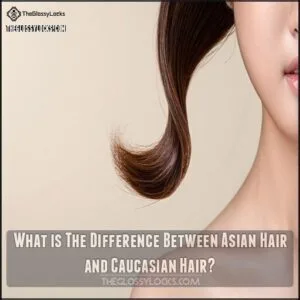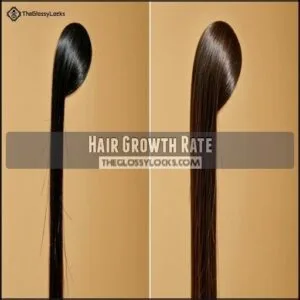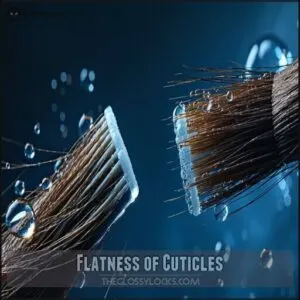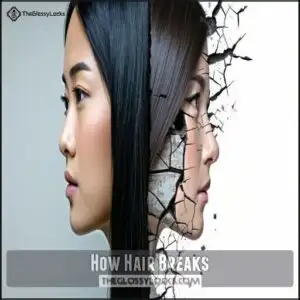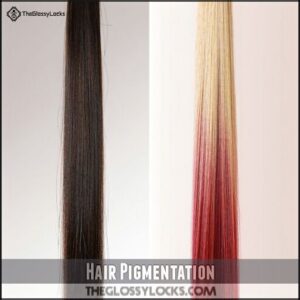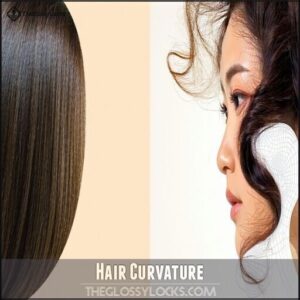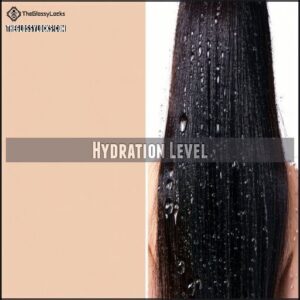This site is supported by our readers. We may earn a commission, at no cost to you, if you purchase through links.
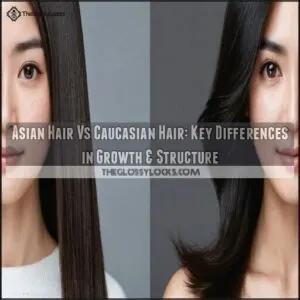
Asian hair tends to be thicker, straighter, and grows faster—kind of like that overachieving cousin you’re slightly jealous of.
Its cuticles are steeper, with wider gaps that make it tougher and more resistant to damage.
Caucasian hair, on the other hand, is more versatile in texture—straight, wavy, or curly—and has a smaller cross-sectional diameter, making it more flexible but prone to breakage.
Asian hair’s darker pigmentation also protects it from the sun, while Caucasian hair varies widely in color.
Curious how these traits impact hair care, and how they relate to hair care? Keep reading!
Table Of Contents
- Key Takeaways
- What is The Difference Between Asian Hair and Caucasian Hair?
- Hair Growth Rate
- Number of Cuticle Layers
- Flatness of Cuticles
- Distance Between Cuticles
- How Hair Breaks
- Why Hair Breaks
- Hair Pigmentation
- Hair Curvature
- Hydration Level
- Frequently Asked Questions (FAQs)
- Are Asian women more bald than Caucasians?
- What is the difference between Asian and Caucasian hair?
- Do Caucasians have thin hair?
- Is caucasian hair straight or wavy?
- Why is Asian hair thinner than Caucasian?
- What are the characteristics of Caucasian hair?
- How Can I Care for My Asian/Caucasian Hair?
- What Products Should I Use to Style My Asian/Caucasian Hair?
- Are There Any Special Techniques to Styling Asian/Caucasian Hair?
- Are There Any Special Considerations When Coloring Asian/Caucasian Hair?
- Conclusion
Key Takeaways
- Asian hair is thicker, straighter, and grows faster, with dense cuticles that make it resilient but prone to chemical damage.
- Caucasian hair varies in texture—straight, wavy, or curly—with thinner strands that are more fragile but versatile for styling purposes.
- Asian hair’s darker pigmentation provides natural UV protection, while Caucasian hair displays a wider range of colors due to varying melanin levels.
- Asian hair maintains higher hydration thanks to compact cuticle layers, while Caucasian hair needs more moisture care due to its thinner, less dense cuticles.
What is The Difference Between Asian Hair and Caucasian Hair?
Asian hair and Caucasian hair differ in fascinating ways, from texture to growth patterns and even scalp health.
Asian hair is typically straight, thicker, and more resilient, with a round follicle shape contributing to its smooth texture. On the flip side, Caucasian hair showcases diverse textures—straight, wavy, or curly—with oval-shaped follicles giving it finer elasticity.
Asian hair is straighter and thicker, while Caucasian hair varies from straight to curly, offering unique texture and elasticity.
Growth patterns also vary; Asian hair grows faster, averaging 1.4 cm per month, while Caucasian hair grows around 1.2 cm monthly. The cuticle layers in Asian hair are denser, offering more durability, but it’s also prone to breakage due to weaker inner proteins.
Understanding hair porosity types is essential for effective hair care. These fundamental differences make each hair type unique, influencing care routines and how each responds to products or treatments.
Hair Growth Rate
Ever wondered why your growth patterns differ from those of other ethnicities? Hair growth rate varies substantially between Asian and Caucasian hair types due to biological differences in their structure.
Asian hair grows faster at approximately 1.4 cm per month, while Caucasian hair typically grows at a slower 1.2 cm per month. This difference in hair growth is influenced by several factors including follicle depth and scalp health.
The science behind this variation relates to hair density and cross-sectional area. Asian hair has a greater diameter and cross-sectional area, which contributes to its faster growth cycle.
These structural differences affect how nutrients are delivered to the hair shaft. Growth factors in Asian hair also benefit from the distance between the hair strand’s diameter and cuticle spacing, creating ideal conditions for faster development.
Understanding the biology behind asian hair vs caucasian hair growth rates can help you better care for your specific hair type and set realistic expectations for growth timelines. To learn more about the distinct characteristics of each hair type, consider researching hair structure differences.
Number of Cuticle Layers
The structure of hair cuticle layers reveals significant differences between ethnic groups.
Asian hair typically features around 10 cuticle layers, while Caucasian hair averages only 5 layers.
This cuticle thickness directly affects hair shaft strength and resilience.
Learn more about Asian and Caucasian hair.
The cuticle cells in Asian hair are wider, denser, and more compactly arranged, contributing to its robust structure.
This higher cuticle density explains why Asian hair generally resists breakage better than Caucasian hair.
However, this same structure makes Asian hair more susceptible to chemical damage from treatments.
Understanding your hair’s cuticle function and layer adhesion is essential for proper care.
Flatness of Cuticles
Your hair’s cuticle shape dramatically influences its texture and manageability.
Caucasian hair typically has flatter cuticles compared to Asian hair, where cuticle inclination is steeper. This difference affects everything from frizz control to hair porosity.
Proper hair cuticle maintenance is essential for overall hair health.
The cuticle layers of Asian hair lie at a more pronounced angle, creating:
- A smoother surface that reflects light better, giving that enviable shine
- Greater resistance to water absorption, reducing susceptibility to humidity
- More difficulty holding curls due to the tightly compact cuticle structure.
These structural differences explain why hair texture varies so substantially between ethnicities.
Distance Between Cuticles
Looking at your hair under a microscope reveals that the distance between cuticles substantially differs across ethnic groups.
In Asian hair, cuticle layers sit closer together with minimal intercuticle distance, creating that characteristic smooth, straight appearance.
Caucasian hair cuticle thickness is generally less substantial, with wider gaps between layers of the hair shaft structure.
This cuticle space affects everything from hair texture to how products penetrate your strands.
Tighter cuticle adhesion in Asian hair explains its natural shine and moisture retention, while the greater follicle depth and spacing in Caucasian hair contributes to its diverse range of textures and styling versatility.
How Hair Breaks
Did you know that Asian and Caucasian hair break in fundamentally different ways due to their unique structures? Understanding these breakage patterns can help you protect your precious strands.
- Asian hair typically breaks off from the scalp as large, intact pieces that maintain their shape
- Caucasian hair tends to fracture into smaller fragments due to its more fragile cuticle structure
- Under extension stress, Asian hair cuticles fail as large pieces while preserving their form
- Caucasian cuticles often collapse completely, creating tiny fragments when damaged
These distinct hair fracture patterns are confirmed by microscopic measurements showing Caucasian hair’s greater fragility compared to Asian hair’s structural resilience.
Why Hair Breaks
When examining breakage causes, the key differences between Asian and Caucasian hair become evident in their structural properties.
Asian hair’s lower inter-cuticle distance makes these strands more prone to fracture from heat styling and chemical treatments. The hair shaft in Asian hair contains weaker adhesive proteins despite having greater cross-sectional area, affecting hair elasticity.
Meanwhile, Caucasian hair tends to have stronger cuticle adhesion but is generally more fragile overall.
Hair porosity also plays a significant role—higher porosity can lead to split ends and fragile strands if not properly maintained through appropriate care routines. The combination of these factors, including the impact of heat styling and chemical treatments, highlights the importance of understanding hair porosity in maintaining healthy hair.
Hair Pigmentation
Pigmentation’s signature effect on Asian and Caucasian hair extends beyond mere appearance. When examining the science behind hair color, differences become evident.
- Asian hair primarily contains higher eumelanin levels, producing dark brown to black shades
- Caucasian hair displays wider color variance from blonde to red to dark brown
- Melanin levels increase in Asian hair with age, darkening over time
- Eumelanin role includes providing natural UV protection for hair strands
- Pigment distribution affects hair’s resistance to damage, with darker hair typically showing greater strength
Understanding these pigmentation differences helps explain why hair care needs vary between these genetic backgrounds, due to the distinct characteristics of each hair type.
Hair Curvature
One striking difference between hair types is their natural curvature.
Asian hair typically grows straight and cylindrical from round follicles, creating smooth strands that extend perpendicularly from the scalp.
In contrast, Caucasian hair displays a wider variety of curl patterns, from straight to wavy or curly, due to its oval-shaped cross-section.
This fundamental difference in hair bending affects how each type responds to styling.
While Asian hair may resist holding curls, Caucasian hair can be more versatile but often requires more moisture to maintain its natural texture.
The bent strands of Caucasian hair also create different light reflection patterns, affecting how shiny the hair appears.
Hydration Level
You’ll find that Asian hair typically maintains higher hydration levels than Caucasian hair, contributing to its characteristic shine and resilience.
This increased moisture retention stems from Asian hair’s unique structural properties, including more compact cuticle layers and larger cross-sectional area, which can be considered complete concepts and characteristic.
Cuticle Layering
The remarkable difference in cuticle layering between hair types substantially impacts hydration levels.
Asian hair boasts approximately 10 cuticle layers—wider, thicker, and more densely compacted than Caucasian hair’s typical 5 layers.
This structural variation affects moisture retention and cell density throughout the hair shaft.
The compactness level of these protective scales determines how effectively your hair locks in hydration.
Asian hair’s greater cuticle thickness and stronger layer structure create a more effective moisture barrier, while Caucasian hair’s thinner cuticle system allows for different hydration patterns.
Understanding proper hair care products is essential for maintaining healthy hair.
Cross-Sectional Area of The Hair
The cross-sectional area of your hair substantially impacts its hydration level.
Asian hair strands typically have a larger hair diameter and cross-sectional area compared to Caucasian hair, allowing them to retain moisture more effectively.
This difference in hair shaft structure contributes to Asian hair’s higher porosity and moisture retention capabilities.
The wider fiber strength and cuticle width of Asian hair strands create more space for water molecules to be absorbed and maintained within the hair structure.
Understanding hair hydration products, such as those related to Asian hair care, is essential for maintaining healthy and moisturized hair.
Curvature and Straightness
The structural differences between Asian and Caucasian hair extend to their natural curvature. Asian hair typically grows straight from the follicle with a circular cross-section, giving it that characteristic straight texture and uniform strand alignment.
Caucasian hair displays more variation in curl patterns and hair bend, ranging from straight to wavy or curly due to its oval-shaped follicles.
This natural hair texture substantially impacts how each hair type responds to styling, particularly straight styles. Understanding hair straightener techniques is essential for achieving desired results with hair straight tools.
Pigmentation
Moving from hair straightness to pigmentation reveals another fascinating contrast.
Asian hair typically displays darker pigmentation, primarily due to higher eumelanin levels. This dark melanin content gives Asian hair its characteristic black or dark brown shades.
Caucasian hair exhibits a wider spectrum from blonde to red to brown. The pigment distribution in Asian hair is more uniform, offering better protection against UV damage.
Melanogenesis (the process of melanin formation) occurs differently between these hair types, with pheomelanin appearing more frequently in Caucasian hair, contributing to lighter or reddish tones, and affecting the overall melanin formation in distinct ways.
Frequently Asked Questions (FAQs)
Are Asian women more bald than Caucasians?
Hair loss is like a puzzle, shaped by genes and hormones.
Asian women generally experience less baldness than Caucasians due to stronger cuticles and slower hair thinning.
However, factors like age, stress, and health still matter.
What is the difference between Asian and Caucasian hair?
Asian hair is usually thicker, straighter, and grows faster, while Caucasian hair varies in texture and color.
Due to differences in structure, Asian hair is stronger but prone to chemical damage, unlike more fragile Caucasian hair that is fragile.
Do Caucasians have thin hair?
Caucasians can have thin hair, but it depends on genetics, age, and health.
Their hair strands are typically thinner with an oval cross-section, and they often have higher hair density, balancing the appearance of thickness.
Is caucasian hair straight or wavy?
Caucasian hair can do it all—it’s like the undecided artist of hair textures.
You’ll often find it straight, wavy, or curly, shaped by genetics and an oval hair strand structure that brings unpredictable versatility.
Why is Asian hair thinner than Caucasian?
It’s not actually thinner!
While Asian hair strands are thicker with a larger diameter, they’re less dense overall, meaning fewer hairs per square centimeter compared to Caucasian hair.
This creates the perception of thinner hair, as the lower density of Asian hair strands gives this impression, even though the individual strands are actually thicker.
What are the characteristics of Caucasian hair?
You’ll find Caucasian hair varies widely in color and texture, from straight to curly.
It grows slower at 2 cm per month, has fragile cuticles, an oval shape, and tends to need more moisture.
How Can I Care for My Asian/Caucasian Hair?
To care for your hair, focus on hydration, avoid overwashing, and choose products suited to your hair type.
Use natural oils for protection, rinse with cold water, and avoid excessive heat to prevent damage.
What Products Should I Use to Style My Asian/Caucasian Hair?
Don’t reinvent the wheel—opt for lightweight serums for shine, sea salt spray for texture, and heat protectants before styling.
Tailor products to your hair’s structure to enhance natural strength and prevent damage.
Are There Any Special Techniques to Styling Asian/Caucasian Hair?
For Asian hair, use texturizing sprays to add volume and grip before styling.
Caucasian hair benefits from heat protectants and mousse for hold.
Tailor tools like curling irons and straighteners based on your texture.
Are There Any Special Considerations When Coloring Asian/Caucasian Hair?
It’s fascinating how hair absorbs color differently.
With Asian hair’s dense cuticles, color may resist or deposit unevenly, requiring pre-lightening.
Caucasian hair’s porous nature grabs dye faster but risks over-processing.
Adjust techniques accordingly!
Conclusion
Hair differences mightn’t solve world peace, but understanding Asian hair vs Caucasian hair can save you some bad hair days.
Asian hair’s thicker strands and straight structure grow faster and handle more damage, while Caucasian hair’s flexibility shines with its versatile textures.
The steeper cuticles and darker pigmentation of Asian hair protect it from wear, while Caucasian hair’s finer composition requires gentler care.
Play to your hair’s strengths, and don’t let its quirks stress you out, focusing on its unique features like versatile textures.
- https://thebeautybrains.com/2007/01/5-ways-that-asian-hair-is-different-from-caucasian-hair/
- https://pmc.ncbi.nlm.nih.gov/articles/PMC7187942/
- https://eugenixhairsciences.com/blog/everything-about-caucasian-and-asian-hair.php
- https://www.rehairducation.com/what-is-it-about-our-hair-diffrences-between-afro-asian-and-caucasian-hair/
- https://www.reddit.com/r/asian/comments/gjraw2/how_is_asian_curly_hair_different_than_caucasian/

